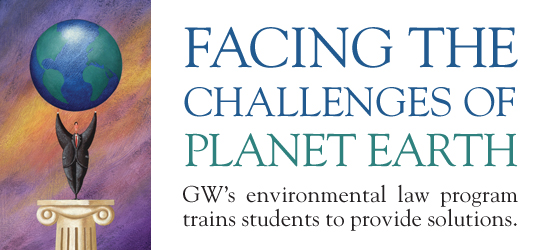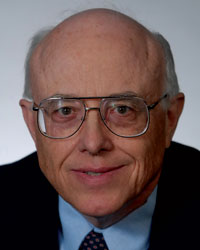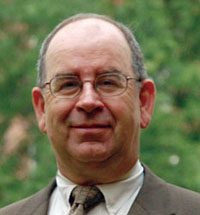
By Julia Parmley
In 1970, Arnold W. Reitze Jr. traveled from Cleveland, Ohio, to Washington, D.C., to begin an environmental law program at GW Law that was being funded with $250,000 from the Ford Foundation. The program was one of the first of its kind in the United States.

Arnold W. Reitze Jr., the J.B. and Maurice C. Shapiro Professor Emeritus of Environmental Law
Over the next 38 years, Reitze, GW’s J.B. and Maurice C. Shapiro Professor Emeritus of Environmental Law, created a groundbreaking curriculum that included many courses in pollution control as well as in natural resources, water pollution, wetlands, and land use. Today, the program is ranked 16th in the country by U.S. News & World Report and offers more than 20 classes taught by some of the nation’s foremost environmental law and policy experts.
And with Associate Dean for Environmental Law Studies Lee Paddock’s five-year plan, the program is poised to become even better.
Environmental law was almost unheard of on the East Coast until Reitze came to GW. A leading expert on air pollution, he first began working in the field in the 1960s in Ohio, where he helped create local groups to fight for clean air and water. Reitze worked to implement the Clear Air Act in 1963 and wrote the Cleveland air pollution code. At Case Western Reserve University in Cleveland, Reitze began to develop the university’s first environmental courses, and in 1970 he was given the opportunity to create an environmental law program at GW.
Reitze believes environmental law always has been a field of rapid change. At GW he saw firsthand how the need for courses, internships, and faculty members evolved with the issues of the times. For example, when oil prices increased in the 1970s due to an oil embargo, the interest in energy and the environment increased. When oil prices dropped in the 1980s, interest in the subject declined. Today, it once again is a major part of environmental law, Reitze says.
“At GW we developed one of the largest environmental law curriculums in the country,” Reitze says. “But it was close to impossible to keep up all the developments concerning climate change.”
Reitze also helped train military JAG officers and U.S. Department of Defense civilian attorneys to ensure compliance with environmental laws. Once neglectful of such measures, Reitze says the military is now a strong champion for the environment.
Reitze, who has written six books and more than 50 research studies and articles on environmental law, currently is a professor at the University of Utah’s S.J. Quinney College of Law. He says working in the environmental field can offer great and lasting rewards.
“The environmental field is perfect for those who like to be constantly at the cutting edge of problems that do not yet have answers,” he says. “I had a great and pleasant run at GW. It always had strong students, and Lee is going to be a great leader.”
Like Reitze, Paddock has seen interest in the environment increase and wane over the course of his 30-year career. He witnessed a rise in community-based environmental movements across the country inspired by Earth Day in 1970. From the law practice perspective, Paddock believes it was the passage of the Comprehensive Environmental Response, Compensation, and Liability Act in 1980, legislation that established legal responsibility for cleaning up property that had been contaminated by hazardous waste, that significantly expanded the niche for environmental lawyers.
“In the last few years, increasing understanding of the effects of climate changes and events like Hurricane Katrina put environmental issues on the front burner again,” Paddock explains. “There also is a renewed interest among students in social issues. Students, nationally and at GW, have become increasingly interested in the health of the planet. Climate change, fisheries depletion, dead zones in our estuaries, and energy issues have driven interest in the concept of sustainable development and the legal steps that must be taken to achieve this difficult goal.

Lee Paddock, associate dean for environmental law studies
“These are increasingly seen not just as social or scientific issues, but also as issues at the core of the long-term viability of businesses,” Paddock notes.
This trend also is reflected in student applications. Paddock says more than 80 students who have been accepted into GW Law School for the 2008-09 academic year indicated an interest in environmental law. Approximately 20 to 25 students currently are enrolled in the master’s degree program, which offers three fields of study in environmental law, government procurement and environmental law, and international environmental law. GW also has a network of more than 600 environmental program alumni who Paddock says consistently support the program.
“I think that among the top 20 law schools in the country, we have one of the highest numbers in environmental law,” he says. “We are committed to building an excellent environmental program at GW and making it one of the best in
the country.”
Prior to joining GW in spring 2007, Paddock was the director of environmental legal studies at Pace University Law School in New York since 2002. He says he was drawn to GW because of its many strengths, including international and trade law programs and its proximity to policy makers and nongovernmental organizations. He now is working on implementing a five-year plan to reenergize the program through a revamped curriculum, an increased focus on having a direct impact on environmental policy, and partnerships with international institutions.
Paddock says GW Law School Dean Frederick M. Lawrence and Associate Dean for Academic Affairs and Professor of Clinical Law Jeffrey S. Gutman support the plan, which he says will capitalize on GW Law’s proximity to the nation’s decision-makers. “There are few programs in the country that directly engage students in environmental policy work and GW is the ideal place to do that,” Paddock says.
Paddock first wants to create opportunities for students to gain practical experience. A new environmental lawyering course will serve as the focal point for student internships with environmental organizations and government agencies. And the planned Environmental Policy Clinic will provide a unique opportunity for students to gain hands-on experience researching environmental policy issues, preparing testimony, filing comments on federal rules, and drafting legislation.
“There are very few opportunities for students to get that experience while they are studying,” Paddock says.
Changes also are in store for the program’s curriculum.
Paddock wants to develop a separate climate change class and incorporate interdisciplinary teaching among other schools at GW. For example, in cooperation with Mark Starik in GW’s business school, a new course in the spring 2009 semester will offer business and law students a chance to study together in an interdisciplinary climate change course. Paddock and Starik, chair of the business school’s Department of Strategic Management and Public Policy, are members of GW’s Presidential Task Force on Sustainability. Paddock believes these kinds of course collaborations “reflect the kinds of issues that lawyers will face today.”
Paddock also expects to find ways to integrate the work of the environmental law program with GW Law’s international law and trade law programs. A planned conference on U.S. Environmental Diplomacy is one way he hopes to build on the combined strengths of GW’s programs. The environmental law program, with the President’s Council on Environmental Quality and the Environmental Law Institute, will co-host a conference in spring 2009 celebrating the 40th anniversary of the National Environmental Policy Act, a law that requires federal agencies to consider the environmental impacts of federal projects. It was the first major environmental law of the modern era.
The program’s connections abroad also will be expanded with international internships, summer programs, joint master’s degree programs, and semesters abroad. Paddock has met with faculty at the University of Ottawa, the University of Gronigen in the Netherlands, and the Bilgi University in Turkey to discuss potential areas of collaboration.
“Since environmental issues are increasingly international, we feel we should build additional opportunities for students to learn environmental law in an international context,” he says. “These kinds of opportunities are essential to the long-term direction of the program and should help GW Law School to attract international students to pursue a master’s degree in environmental law.”
Environmental law will be an increasingly important element of the growing worldwide effort to find solutions to environmental problems. Paddock believes GW can and should play an important role in training the next generation of lawyers to meet this challenge.
“The nature of our long-term environmental challenges calls upon universities to think differently about their role,” he says. “President Knapp has led this effort at GW by encouraging the University as a whole to focus on the challenges presented by the concept of sustainable development. GW is particularly well suited to lead in this area because of its location and its strengths in environmental law, public health, business, and science. We have both an obligation and an opportunity to make a real difference for our students and for our environment.”
Climate Commitment
GW Law strengthened its commitment to environmental sustainability in June by becoming the first law school in the nation to participate in the Law Office Climate Challenge, jointly sponsored by the American Bar Association and U.S. Environmental Protection Agency.
The initiative, created in 2007, is designed to encourage law offices to take specific steps to conserve energy and resources, as well as reduce emissions of greenhouse gases and other pollutants. GW Law is meeting the challenge by participating in the “Best Practices for Office Paper Management” program. The Law School now uses 30 percent recycled content paper for copying and printing, encourages staff to use double-sided copying, and provides recycling receptacles for all offices with the goal of recycling 90 percent of mixed office paper.
“Law schools, like law firms, use a tremendous amount of paper,” says Lee Paddock, associate dean for environmental law studies. “It is important in an increasingly resource-constrained world that we all be thoughtful about how we carry out our mission while conserving resources and, at the same time, help our students understand that they can take practical steps throughout their work life to contribute to a more sustainable future.”
GW Law joins 74 challenge members nationwide, including private firms such as Arnold & Porter, Beveridge & Diamond, and Weil, Gotschal and Manges. Dean Frederick M. Lawrence says that GW is pleased to be the first law school to join the initiative. “GW Law has been dedicated to the field of environmental law for nearly 40 years, and we are delighted to play a major role in our university’s sustainability initiatives,” he says. “This is not just something we study and teach, but something we practice and in which we lead by example.” |
|